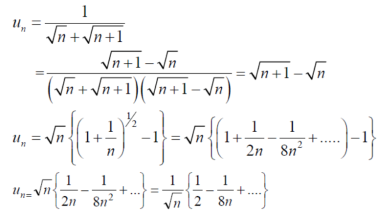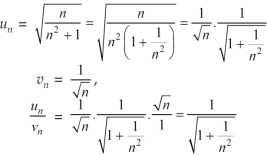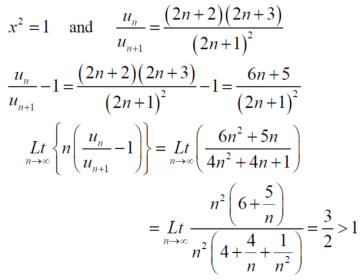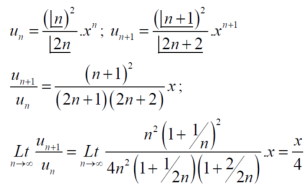Unit – 5
Infinite Series
Q1) If  , then the limit of
, then the limit of  will be?
will be?
A1)
 =
=  =
=  = ½
= ½
Hence the limit of the sequence is 1/2.
Q2) Define convergent and divergent sequence.
A2)
Convergent sequence- A sequence Sn is said to be convergent when it tends to a finite limit. That means the limit of a sequence Sn will be always finite in case of convergent sequence.
Divergent sequence- when a sequence tends to ±∞ then it is called divergent sequence.
Oscillatory sequence- when a sequence neither converges nor diverges then it is called oscillatory sequence.
Q3) check whether the series  is convergent or divergent. Find its value in case of convergent.
is convergent or divergent. Find its value in case of convergent.
A3)
As we know that,
Sn = 
Therefore,
Sn = 
Now find out the limit of the sequence,
 = ∞
= ∞
Here the value of the limit is infinity, so that the series is divergent as sequence diverges.
Q4) check whether the series  is convergent or divergent.
is convergent or divergent.
A4)

We get on applying limits,
 ) = 3/4
) = 3/4
This is the convergent series and its value is 3 / 4
Q5) Prove that the following series is convergent and find its sum.

A5)
Here,

And


Hence the series is convergent and the limit is 1/2 .
Q6) Test the convergence of the series- 
A6)
Here we can see that the given series is in geometric progression
As its first term is 1 and common ratio is ½.
Then we know that the sum of n terms of a geometric progression is-

Hence the limit will be-

So that the series is convergent.
Q7) State and prove comparison test.
A7)
Statement-
Suppose we have two series of positive terms  and
and  then,
then,
 , where k is a finite number, then both series converges or diverges together.
, where k is a finite number, then both series converges or diverges together.
Proof- we know that by the definition of limits, there exist a positive number epsilon(ε)
Which is very small. Such that
According to definition( comparison test)
| |<ε for n>m, that means
|<ε for n>m, that means
k-ε< for n>m
for n>m
Ignoring the first m terms of the series,
We get
k-ε< for n>m for all n ………………..(1)
for n>m for all n ………………..(1)
There will be two cases-
Case-1:  is convergent, then
is convergent, then
 (
( ) = r (say), where r is finite number
) = r (say), where r is finite number
From (1),

 (
( )<
)< (
( ) =
) = 
Therefore  is also convergent.
is also convergent.
Case-2:  is divergent, then
is divergent, then
 (
( )→∞ …………………………..(2)
)→∞ …………………………..(2)
From eq. (1)


Then
 (
( )<
)< (
( )
)
From(2)
 (
( )→∞
)→∞
Hence,  is also divergent.
is also divergent.
Q8) Test the convergence of the following series.

A8)
We have 
First we will find  and the
and the 


And

Here, we can see that, the limit is finite and not zero,
Therefore,  and
and  converges or diverges together.
converges or diverges together.
Since  is of the form
is of the form  where p = 2>1
where p = 2>1
So that, we can say that,
 is convergent, so that
is convergent, so that  will also be convergent.
will also be convergent.
Q9) Test the series:

A9)
The series is,

Now,

Take,


= 1/2
Which is finite and not zero.
By comparison test  and
and  converge or diverge together.
converge or diverge together.
But,

Is divergent. ( p = ½)
So that  is divergent.
is divergent.
Q10) Test the convergence of the series whose n’th term is given below-
n’th term = 
A10)
We have
 and
and 
By D’Alembert ratio test,

So that by D’Alembert ratio test, the series will be convergent.
Q11) Test for the convergence of the n’th term of the series given below-

A11)
We have,



Now, by D’Alembert ratio test  converges if
converges if  and diverges if
and diverges if 
At x = 1, this test fails.
Now, when x = 1


The limit is finite and not zero.
Then by comparison test,  converges or diverges together.
converges or diverges together.
Since  is the form of
is the form of  , in which
, in which 
Hence  diverges then
diverges then  will also diverge.
will also diverge.
Therefore in the given series  converges if x<1 and diverges if x≥1.
converges if x<1 and diverges if x≥1.
Q12) Test the convergence of the series whose nth term is given below-

A12)

By root test  is convergent.
is convergent.
Q13) Test the convergence of the series whose nth term is given below-

A13)


By root test  is convergent.
is convergent.
Q14) Test the convergence of the following series:

A14)
Here, we have,




Therefore the given series is convergent.
Q15) Test the convergence of the following series.

A15)
Neglecting the first term the series can be written as,


So that,


By ratio test  converges if |x|<1 and diverges if |x|>1, but if |x| = 1 the the test fails,
converges if |x|<1 and diverges if |x|>1, but if |x| = 1 the the test fails,
Then,

By Rabies’s test  converges hence the given series is convergent when |x|≤ 1 and divergent If |x| >1.
converges hence the given series is convergent when |x|≤ 1 and divergent If |x| >1.
Q16) Test the nature of the following series:

A16)

By ration test  is convergent when (x/4)<1 and divergent when x>4, when x= 4,
is convergent when (x/4)<1 and divergent when x>4, when x= 4,
The ratio test fails, then

By Rabee’s test  is convergent, hence the given series is convergent when x<4 and divergent If x >=4.
is convergent, hence the given series is convergent when x<4 and divergent If x >=4.
Q17) Test the convergence of the following alternating series:

A17)
Here in the series, we have


First condition-


So that,
| | > |
| > | |
|
That means, each term is not numerically less than its preceeding terms.
Now second condition-

Both conditions are not satisfied for convergence.
Hence the given series is not convergent. It is oscillatory.
A18) Test for absolute convergence:

A18)
Let the series is  ,
,


By ratio test,
 is convergent, if |x|<1.
is convergent, if |x|<1.
 is absolutely convergent if |x|< 1.
is absolutely convergent if |x|< 1.
Q18) Test the convergence/Divergence of the series:

A19)
Here the given series is alternately negative and positive , which is also a geometric infinite series.
1. Suppose,
S = 
According to the conditions of geometric series,
Here, a = 5 , and common ratio (r) = -2/3
Thus, we know that,

So,
Sum of the series is finite, which is 3.
So we can say that the given series is convergent.
Now.
Again sum of the positive terms,

The series is geometric, then
A = 5 and r = 2/3 , then
Sum of the series,

Sum of the series is finite then the series is convergent.
Both conditions are satisfied, then the given series is absolutely convergent.